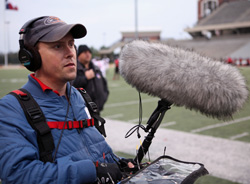
“Friday Night Tykes” on Esquire—an NBCUniversal network—is a TV show that focuses on the competitive Rookies division in the San Antonio region of the Texas Youth Football Association. The series follows five different teams, both on and off the football field. There’s a lot of action, and Digital Hybrid Wireless technology from Lectrosonics helps capture it.
Austin, TX-based location sound engineer John McKallip is one of two lead sound mixers on the show, working with Allen Green from San Antonio. The two track and capture all the action, and ensure the sound quality. McKallip’s track record includes running sound for Amy Poehler’s Smart Girls at the Party, Ironman World Championship Live coverage, CBS’ 60 Minutes, and the NBC Winter Olympics in Sochi. “Friday Night Tykes presents a different challenge.
“Weeks were filled with football practices and home life,” McKallip explains “Then each week ended with a game day. Each pack needed to take in multiple talent mics, send a stereo mix to their camera man, send a reference track to a smaller producer camera, and provide IFB for up to four producers.
“To address these requirements, every pack had some combination of Lectrosonics UCR411a receivers, an SRa or SRb dual-channel slot mount ENG receiver, and a few SMQV super-miniature transmitters. On the outgoing side, the setup typically included the mixer feeding two UM400 beltpack or SMV Super-Miniature transmitters over to an SRb dual channel receiver mounted to XDCAM 800 cameras for the stereo mix.”
McKallip also reports that the IFB setup included either a Lectrosonics T4 IFB transmitter or an LMa beltpack transmitter set to IFB compatibility mode feeding Lectrosonics R1a IFB receivers. This setup was used primarily by the producers, but was sometimes mounted to a secondary camera to feed a reference sound. “We made use of the programming feature so the producers could easily switch their unit to hear the right mix of characters.
“Lectrosonics is the total package,” he continues. “The transmitters—the SMQVs—in this case, have a wide dynamic range so that you get the full color of the lavaliere you’re using. And Lectrosonics’ build quality is terrific. The Lectrosonics units have always had a reputation for being built like tanks. As we transitioned from UM400a to SMQV transmitters, we discovered that we get the same toughness with more features and easier to operate advanced features, including power output.
“The Lectrosonics SRb receivers were often used as camera hops. These units are a welcome bit of relief for the camera men who have been accustomed to using two larger standalone receivers hanging off the back of their camera for so many years. Further, the range of these units is remarkable.”
The compact form factor of the Lectrosonics SMQV transmitters has proven to be yet another benefit on the show. “We mounted mics everywhere,” McKallip says. “The small size of the SMQV transmitters gave us infinite options while rarely being seen. And for those times when we simply couldn’t get to those transmitters, we could use the Lectro Remote app on our iPhones to put the unit on standby.”
